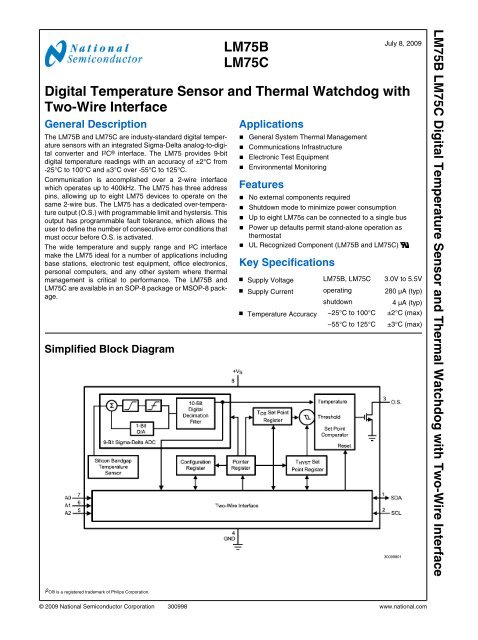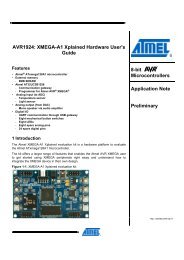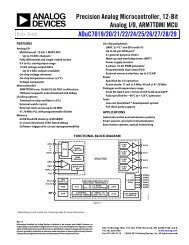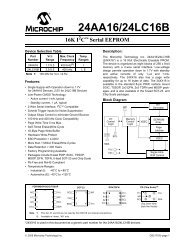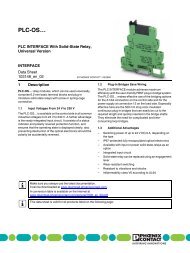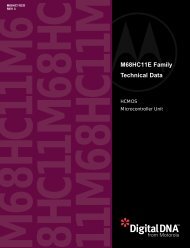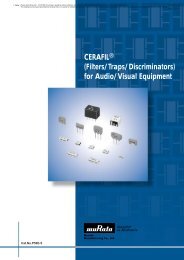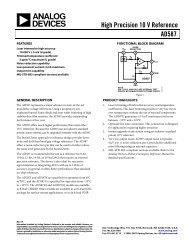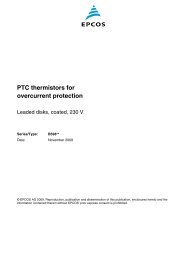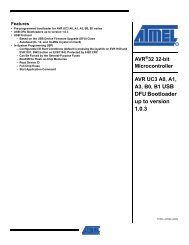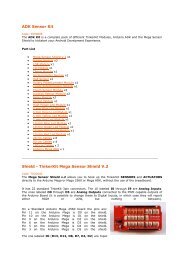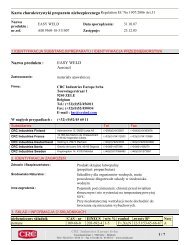LM75B LM75C Digital Temperature Sensor and Thermal ... - Elfa
LM75B LM75C Digital Temperature Sensor and Thermal ... - Elfa
LM75B LM75C Digital Temperature Sensor and Thermal ... - Elfa
Create successful ePaper yourself
Turn your PDF publications into a flip-book with our unique Google optimized e-Paper software.
<strong>LM75B</strong><br />
<strong>LM75C</strong><br />
July 8, 2009<br />
<strong>Digital</strong> <strong>Temperature</strong> <strong>Sensor</strong> <strong>and</strong> <strong>Thermal</strong> Watchdog with<br />
Two-Wire Interface<br />
General Description<br />
The <strong>LM75B</strong> <strong>and</strong> <strong>LM75C</strong> are industy-st<strong>and</strong>ard digital temperature<br />
sensors with an integrated Sigma-Delta analog-to-digital<br />
converter <strong>and</strong> I 2 C ® interface. The LM75 provides 9-bit<br />
digital temperature readings with an accuracy of ±2°C from<br />
-25°C to 100°C <strong>and</strong> ±3°C over -55°C to 125°C.<br />
Communication is accomplished over a 2-wire interface<br />
which operates up to 400kHz. The LM75 has three address<br />
pins, allowing up to eight LM75 devices to operate on the<br />
same 2-wire bus. The LM75 has a dedicated over-temperature<br />
output (O.S.) with programmable limit <strong>and</strong> hystersis. This<br />
output has programmable fault tolerance, which allows the<br />
user to define the number of consecutive error conditions that<br />
must occur before O.S. is activated.<br />
The wide temperature <strong>and</strong> supply range <strong>and</strong> I 2 C interface<br />
make the LM75 ideal for a number of applications including<br />
base stations, electronic test equipment, office electronics,<br />
personal computers, <strong>and</strong> any other system where thermal<br />
management is critical to performance. The <strong>LM75B</strong> <strong>and</strong><br />
<strong>LM75C</strong> are available in an SOP-8 package or MSOP-8 package.<br />
Simplified Block Diagram<br />
Applications<br />
■ General System <strong>Thermal</strong> Management<br />
■ Communications Infrastructure<br />
■ Electronic Test Equipment<br />
■ Environmental Monitoring<br />
Features<br />
■ No external components required<br />
■ Shutdown mode to minimize power consumption<br />
■ Up to eight LM75s can be connected to a single bus<br />
■ Power up defaults permit st<strong>and</strong>-alone operation as<br />
thermostat<br />
■ UL Recognized Component (<strong>LM75B</strong> <strong>and</strong> <strong>LM75C</strong>)<br />
Key Specifications<br />
■ Supply Voltage <strong>LM75B</strong>, <strong>LM75C</strong> 3.0V to 5.5V<br />
■ Supply Current operating 280 μA (typ)<br />
shutdown<br />
4 μA (typ)<br />
■ <strong>Temperature</strong> Accuracy −25°C to 100°C ±2°C (max)<br />
−55°C to 125°C<br />
±3°C (max)<br />
30099801<br />
<strong>LM75B</strong> <strong>LM75C</strong> <strong>Digital</strong> <strong>Temperature</strong> <strong>Sensor</strong> <strong>and</strong> <strong>Thermal</strong> Watchdog with Two-Wire Interface<br />
I 2 C® is a registered trademark of Philips Corporation.<br />
© 2009 National Semiconductor Corporation 300998 www.national.com
<strong>LM75B</strong> <strong>LM75C</strong><br />
Connection Diagram<br />
<strong>LM75B</strong>, <strong>LM75C</strong> SOP-8 <strong>and</strong> Mini MSOP-8<br />
30099802<br />
Pin Descriptions<br />
Label Pin # Function Typical Connection<br />
SDA 1<br />
I 2 C Serial Bi-Directional Data Line.<br />
Open Drain.<br />
From Controller, tied to a pull-up resistor or current source<br />
SCL 2 I 2 C Clock Input From Controller, tied to a pull-up resistor or current source<br />
O.S. 3<br />
Overtemperature Shutdown.<br />
Open Drain Output<br />
GND 4 Power Supply Ground Ground<br />
+V S 8 Positive Supply Voltage Input<br />
Pull–up Resistor, Controller Interrupt Line<br />
DC Voltage from 3V to 5.5V; 100 nF bypass capacitor with<br />
10 µF bulk capacitance in the near vicinity<br />
A0–A2 7,6,5 User-Set I 2 C Address Inputs Ground (Low, “0”) or +V S (High, “1”)<br />
Typical Application<br />
30099803<br />
FIGURE 1. Typical Application<br />
www.national.com 2
Ordering Information<br />
Order Number<br />
Package<br />
Marking<br />
NS Package<br />
Number<br />
Supply<br />
Voltage<br />
Transport Media<br />
<strong>LM75B</strong>IM-3 <strong>LM75B</strong>IM-3 M08A (SOP-8) 3.3V 95 Units in Rail Yes<br />
<strong>LM75B</strong>IMX-3 <strong>LM75B</strong>IM-3 M08A (SOP-8) 3.3V 2500 Units on Tape <strong>and</strong> Reel Yes<br />
<strong>LM75B</strong>IMM-3 T01B MUA08A (MSOP-8) 3.3V 1000 Units on Tape <strong>and</strong> Reel Yes<br />
<strong>LM75B</strong>IMMX-3 T01B MUA08A (MSOP-8) 3.3V 3500 Units on Tape <strong>and</strong> Reel Yes<br />
<strong>LM75B</strong>IM-5 <strong>LM75B</strong>IM-5 M08A (SOP-8) 5V 95 Units in Rail Yes<br />
<strong>LM75B</strong>IMX-5 <strong>LM75B</strong>IM-5 M08A (SOP-8) 5V 2500 Units on Tape <strong>and</strong> Reel Yes<br />
<strong>LM75B</strong>IMM-5 T00B MUA08A (MSOP-8) 5V 1000 Units on Tape <strong>and</strong> Reel Yes<br />
<strong>LM75B</strong>IMMX-5 T00B MUA08A (MSOP-8) 5V 3500 Units on Tape <strong>and</strong> Reel Yes<br />
Noise Filter on<br />
SDA <strong>and</strong> SCL<br />
<strong>LM75C</strong>IM-3 <strong>LM75C</strong>IM-3 M08A (SOP-8) 3.3V 95 Units in Rail Not Available<br />
<strong>LM75C</strong>IMX-3 <strong>LM75C</strong>IM-3 M08A (SOP-8) 3.3V 2500 Units on Tape <strong>and</strong> Reel Not Available<br />
<strong>LM75C</strong>IMM-3 T01C MUA08A (MSOP-8) 3.3V 1000 Units on Tape <strong>and</strong> Reel Not Available<br />
<strong>LM75C</strong>IMMX-3 T01C MUA08A (MSOP-8) 3.3V 3500 Units on Tape <strong>and</strong> Reel Not Available<br />
<strong>LM75C</strong>IM-5 <strong>LM75C</strong>IM-5 M08A (SOP-8) 5V 95 Units in Rail Not Available<br />
<strong>LM75C</strong>IMX-5 <strong>LM75C</strong>IM-5 M08A (SOP-8) 5V 2500 Units on Tape <strong>and</strong> Reel Not Available<br />
<strong>LM75C</strong>IMM-5 T00C MUA08A (MSOP-8) 5V 1000 Units on Tape <strong>and</strong> Reel Not Available<br />
<strong>LM75C</strong>IMMX-5 T00C MUA08A (MSOP-8) 5V 3500 Units on Tape <strong>and</strong> Reel Not Available<br />
<strong>LM75B</strong> <strong>LM75C</strong><br />
3 www.national.com
<strong>LM75B</strong> <strong>LM75C</strong><br />
Absolute Maximum Ratings (Note 1)<br />
Supply Voltage Pin (+V S ) −0.3V to 6.5V<br />
Voltage at A0, A1<strong>and</strong> A2 Pins −0.3V to (+V S + 0.3V) <strong>and</strong><br />
must be ≤ 6.5V<br />
Voltage at OS, SCL <strong>and</strong> SDA Pins −0.3V to 6.5V<br />
Input Current at any Pin (Note 2)<br />
5 mA<br />
Package Input Current (Note 2)<br />
20 mA<br />
Storage <strong>Temperature</strong><br />
−65°C to +150°C<br />
ESD Susceptibility (Note 4) <strong>LM75B</strong> <strong>LM75C</strong><br />
Human Body Model 2500V 1500V<br />
Machine Model 250V 100V<br />
O.S. Output Sink Current<br />
10 mA<br />
O.S. Output Voltage 6.5V<br />
Operating Ratings<br />
Specified <strong>Temperature</strong> Range<br />
(Note 5)<br />
Supply Voltage Range (+V S )<br />
<strong>LM75B</strong>, <strong>LM75C</strong><br />
T MIN to T MAX<br />
−55°C to +125°C<br />
+3.0V to +5.5V<br />
Soldering process must comply with National<br />
Semiconductor's Reflow <strong>Temperature</strong> Profile specifications.<br />
Refer to www.national.com/packaging.(Note 3)<br />
<strong>Temperature</strong>-to-<strong>Digital</strong> Converter Characteristics<br />
Unless otherwise noted, these specifications apply for: +V S = +5 Vdc for <strong>LM75B</strong>IM-5, <strong>LM75B</strong>IMM-5, <strong>LM75C</strong>IM-5, <strong>and</strong><br />
<strong>LM75C</strong>IMM-5; <strong>and</strong> +V S = +3.3 Vdc for <strong>LM75B</strong>IM-3, <strong>LM75B</strong>IMM-3, <strong>LM75C</strong>IM-3, <strong>and</strong> <strong>LM75C</strong>IMM-3 (Note 6). Boldface limits apply<br />
for T A = T J = T MIN to T MAX ; all other limits T A = T J = +25°C, unless otherwise noted.<br />
Accuracy<br />
Parameter<br />
Conditions<br />
Typical<br />
(Note 12)<br />
Limits<br />
(Note 7)<br />
T A = −25°C to +100°C ±2.0<br />
T A = −55°C to +125°C ±3.0<br />
Units<br />
(Limit)<br />
°C (max)<br />
Resolution 9 Bits<br />
<strong>Temperature</strong> Conversion Time (Note 8) 100 300 ms (max)<br />
Quiescent Current<br />
<strong>LM75B</strong><br />
<strong>LM75C</strong><br />
I 2 C Inactive 0.25 0.5 mA (max)<br />
Shutdown Mode, +V S = 3V 4 μA<br />
Shutdown Mode, +V S = 5V 6 μA<br />
I 2 C Inactive 0.25 1.0 mA (max)<br />
Shutdown Mode, +V S = 3V 4 μA<br />
Shutdown Mode, +V S = 5V 6 μA<br />
O.S. Output Saturation Voltage I OUT = 4.0 mA 0.8 V (max)<br />
O.S. Delay (Note 10)<br />
1 Conversion (min)<br />
6 Conversions (max)<br />
T OS Default <strong>Temperature</strong> (Note 11) 80 °C<br />
T HYST Default <strong>Temperature</strong> (Note 11) 75 °C<br />
www.national.com 4
Logic Electrical Characteristics<br />
DIGITAL DC CHARACTERISTICS<br />
Unless otherwise noted, these specifications apply for +V S = +5 Vdc for <strong>LM75B</strong>IM-5, <strong>LM75B</strong>IMM-5, <strong>LM75C</strong>IM-5, <strong>and</strong> <strong>LM75C</strong>IMM-5;<br />
<strong>and</strong> +V S = +3.3 Vdc for <strong>LM75B</strong>IM-3, <strong>LM75B</strong>IMM-3, <strong>LM75C</strong>IM-3, <strong>and</strong> <strong>LM75C</strong>IMM-3 (Note 6). Boldface limits apply for T A = T J =<br />
T MIN to T MAX ; all other limits T A = T J = +25°C, unless otherwise noted.<br />
Symbol Parameter Conditions<br />
V IN(1)<br />
V IN(0)<br />
Logical “1” Input Voltage<br />
Logical “0” Input Voltage<br />
Typical<br />
(Note 12)<br />
Limits<br />
(Note 7)<br />
Units<br />
(Limit)<br />
+V S × 0.7 V (min)<br />
+V S + 0.3 V (max)<br />
−0.3 V (min)<br />
+V S × 0.3 V (max)<br />
I IN(1) Logical “1” Input Current V IN = +V S 0.005 1.0 μA (max)<br />
I IN(0) Logical “0” Input Current V IN = 0V −0.005 −1.0 μA (max)<br />
C IN All <strong>Digital</strong> Inputs 5 pF<br />
I OH<br />
High Level Output Current<br />
<strong>LM75B</strong> V OH = 5V 10 μA (max)<br />
<strong>LM75C</strong> V OH = 5V 100 μA (max)<br />
V OL Low Level Output Voltage I OL = 3 mA 0.4 V (max)<br />
t OF<br />
Output Fall Time<br />
C L = 400 pF<br />
I O = 3 mA<br />
250<br />
ns (max)<br />
<strong>LM75B</strong> <strong>LM75C</strong><br />
I 2 C DIGITAL SWITCHING CHARACTERISTICS<br />
Unless otherwise noted, these specifications apply for V S = +5 Vdc for <strong>LM75B</strong>IM-5, <strong>LM75B</strong>IMM-5, <strong>LM75C</strong>IM-5, <strong>and</strong> <strong>LM75C</strong>IMM-5;<br />
<strong>and</strong> +V S = +3.3 Vdc for <strong>LM75B</strong>IM-3, <strong>LM75B</strong>IMM-3, <strong>LM75C</strong>IM-3, <strong>and</strong> <strong>LM75C</strong>IMM-3C L (load capacitance) on output lines = 80 pF<br />
unless otherwise specified. Boldface limits apply for T A = T J = T MIN to T MAX ; all other limits T A = T J = +25°C, unless otherwise<br />
noted.<br />
The switching characteristics of the LM75 fully meet or exceed the published specifications of the I 2 C bus. The following parameters<br />
are the timing relationships between SCL <strong>and</strong> SDA signals related to the LM75. They are not the I 2 C bus specifications.<br />
Symbol Parameter Conditions<br />
Typical<br />
(Note 12)<br />
Limits<br />
(Note 7)<br />
Units<br />
(Limit)<br />
t 1 SCL (Clock) Period 2.5 μs (min)<br />
t 2 Data in Set-Up Time to SCL High 100 ns (min)<br />
t 3 Data Out Stable after SCL Low 0 ns (min)<br />
t 4 SDA Low Set-Up Time to SCL Low (Start Condition) 100 ns (min)<br />
t 5 SDA High Hold Time after SCL High (Stop Condition) 100 ns (min)<br />
t TIMEOUT SDA Time Low for Reset of Serial Interface (Note 13)<br />
<strong>LM75B</strong><br />
75<br />
325<br />
ms (min)<br />
ms (max)<br />
<strong>LM75C</strong> Not Applicable<br />
30099804<br />
5 www.national.com
<strong>LM75B</strong> <strong>LM75C</strong><br />
Note 1: Absolute Maximum Ratings indicate limits beyond which damage to the device may occur. DC <strong>and</strong> AC electrical specifications do not apply when operating<br />
the device beyond its rated operating conditions.<br />
Note 2: When the input voltage (V I ) at any pin exceeds the power supplies (V I < GND or V I > +V S ) the current at that pin should be limited to 5 mA. The 20 mA<br />
maximum package input current rating limits the number of pins that can safely exceed the power supplies with an input current of 5 mA to four.<br />
Note 3: Reflow temperature profiles are different for lead-free <strong>and</strong> non-lead-free packages.<br />
Note 4: Human body model, 100 pF discharged through a 1.5 kΩ resistor. Machine model, 200 pF discharged directly into each pin. The Charged Device Model<br />
(CDM) is a specified circuit characterizing an ESD event that occurs when a device acquires charge through some triboelectric (frictional) or electrostatic induction<br />
processes <strong>and</strong> then abruptly touches a grounded object or surface.<br />
Note 5: LM75 θ JA (thermal resistance, junction-to-ambient) when attached to a printed circuit board with 2 oz. foil similar to the one shown in Figure 3 is summarized<br />
in the table below:<br />
Device Number<br />
NS Package<br />
Number<br />
<strong>Thermal</strong><br />
Resistance (θ JA )<br />
<strong>LM75B</strong>IM-3, <strong>LM75B</strong>IM-5, <strong>LM75C</strong>IM-3, <strong>LM75C</strong>IM-5 M08A 200°C/W<br />
<strong>LM75B</strong>IMM-3, <strong>LM75B</strong>IMM-5, <strong>LM75C</strong>IMM-3, <strong>LM75C</strong>IMM-5 MUA08A 250°C/W<br />
Note 6: All part numbers of the LM75 will operate properly over the +V S supply voltage range of 3V to 5.5V. The devices are tested <strong>and</strong> specified for rated accuracy<br />
at their nominal supply voltage. Accuracy will typically degrade 1°C/V of variation in +V S as it varies from the nominal value.<br />
Note 7: Limits are guaranteed to National's AOQL (Average Outgoing Quality Level).<br />
Note 8: The conversion-time specification is provided to indicate how often the temperature data is updated. The LM75 can be accessed at any time <strong>and</strong> reading<br />
the <strong>Temperature</strong> Register will yield result from the last temperature conversion. When the LM75 is accessed, the conversion that is in process will be interrupted<br />
<strong>and</strong> it will be restarted after the end of the communication. Accessing the LM75 continuously without waiting at least one conversion time between communications<br />
will prevent the device from updating the <strong>Temperature</strong> Register with a new temperature conversion result. Consequently, the LM75 should not be accessed<br />
continuously with a wait time of less than 300 ms.<br />
Note 9: For best accuracy, minimize output loading. Higher sink currents can affect sensor accuracy with internal heating. This can cause an error of 0.64°C at<br />
full rated sink current <strong>and</strong> saturation voltage based on junction-to-ambient thermal resistance.<br />
Note 10: O.S. Delay is user programmable up to 6 “over limit” conversions before O.S. is set to minimize false tripping in noisy environments.<br />
Note 11: Default values set at power up.<br />
Note 12: Typicals are at T A = 25°C <strong>and</strong> represent most likely parametric norm.<br />
Note 13: Holding the SDA line low for a time greater than t TIMEOUT will cause the <strong>LM75B</strong> to reset SDA to the IDLE state of the serial bus communication (SDA<br />
set High).<br />
30099805<br />
FIGURE 2. <strong>Temperature</strong>-to-<strong>Digital</strong> Transfer Function (Non-linear scale for clarity)<br />
www.national.com 6
<strong>LM75B</strong> <strong>LM75C</strong><br />
30099806<br />
FIGURE 3. Printed Circuit Board Used for <strong>Thermal</strong> Resistance Specifications<br />
7 www.national.com
<strong>LM75B</strong> <strong>LM75C</strong><br />
Typical Performance Characteristics<br />
Static Quiescent Current vs <strong>Temperature</strong> (<strong>LM75C</strong>)<br />
Dynamic Quiescent Current vs <strong>Temperature</strong> (<strong>LM75C</strong>)<br />
30099816<br />
Accuracy vs <strong>Temperature</strong> (<strong>LM75C</strong>)<br />
30099817<br />
30099818<br />
www.national.com 8
1.0 Functional Description<br />
The LM75 temperature sensor incorporates a b<strong>and</strong>-gap type<br />
temperature sensor <strong>and</strong> 9-bit ADC (Sigma-Delta Analog-to-<br />
<strong>Digital</strong> Converter). The temperature data output of the LM75<br />
is available at all times via the I 2 C bus. If a conversion is in<br />
progress, it will be stopped <strong>and</strong> restarted after the read. A<br />
digital comparator is also incorporated that compares a series<br />
of readings, the number of which is user-selectable, to userprogrammable<br />
setpoint <strong>and</strong> hysteresis values. The comparator<br />
trips the O.S. output line, which is programmable for mode<br />
<strong>and</strong> polarity.<br />
The <strong>LM75B</strong> contains all the functionality of the <strong>LM75C</strong>, plus<br />
two additional features:<br />
1. The <strong>LM75B</strong> has an integrated low-pass filter on both the<br />
SDA <strong>and</strong> the SCL line. These filters increase<br />
communications reliability in noisy environments.<br />
2. The <strong>LM75B</strong> also has a bus fault timeout feature. If the<br />
SDA line is held low for longer than t TIMEOUT (see<br />
specification) the <strong>LM75B</strong> will reset to the IDLE state (SDA<br />
set to high impedance) <strong>and</strong> wait for a new start condition.<br />
The TIMEOUT feature is not functional in Shutdown<br />
Mode.<br />
1.1 O.S. OUTPUT, T OS AND T HYST LIMITS<br />
In Comparator mode the O.S. Output behaves like a thermostat.<br />
The output becomes active when temperature exceeds<br />
the T OS limit, <strong>and</strong> leaves the active state when the temperature<br />
drops below the T HYST limit. In this mode the O.S. output<br />
can be used to turn a cooling fan on, initiate an emergency<br />
system shutdown, or reduce system clock speed. Shutdown<br />
mode does not reset O.S. state in a comparator mode.<br />
In Interrupt mode exceeding T OS also makes O.S. active but<br />
O.S. will remain active indefinitely until reset by reading any<br />
register via the I 2 C interface. Once O.S. has been activated<br />
by crossing T OS , then reset, it can be activated again only by<br />
<strong>Temperature</strong> going below T HYST . Again, it will remain active<br />
indefinitely until being reset by a read. Placing the LM75 in<br />
shutdown mode also resets the O.S. Output.<br />
1.2 POWER UP AND POWER DOWN<br />
The LM75 always powers up in a known state. The power up<br />
default conditions are:<br />
1. Comparator mode<br />
2. T OS = 80°C<br />
3. T HYST = 75°C<br />
4. O.S. active low<br />
5. Pointer = “00”<br />
When the supply voltage is less than about 1.7V, the LM75 is<br />
considered powered down. As the supply voltage rises above<br />
the nominal 1.7V power up threshold, the internal registers<br />
are reset to the power up default values listed above.<br />
1.2.1 St<strong>and</strong>-Alone Thermostat Mode<br />
If the LM75 is not connected to the I 2 C bus on power up, it will<br />
act as a st<strong>and</strong>-alone thermostat with the power up default<br />
conditions listed above. It is optional, but recommended, to<br />
connect the address pins (A2, A1, A0) <strong>and</strong> the SCL <strong>and</strong> SDA<br />
pins together <strong>and</strong> to a 10k pull-up resistor to +V S for better<br />
noise immunity. Any of these pins may also be tied high separately<br />
through a 10k pull-up resistor.<br />
1.3 I 2 C BUS INTERFACE<br />
The LM75 operates as a slave on the I 2 C bus, so the SCL line<br />
is an input (no clock is generated by the LM75) <strong>and</strong> the SDA<br />
line is a bi-directional serial data path. According to I 2 C bus<br />
specifications, the LM75 has a 7-bit slave address. The four<br />
most significant bits of the slave address are hard wired inside<br />
the LM75 <strong>and</strong> are “1001”. The three least significant bits of<br />
the address are assigned to pins A2–A0, <strong>and</strong> are set by connecting<br />
these pins to ground for a low, (0); or to +V S for a high,<br />
(1).<br />
Therefore, the complete slave address is:<br />
1 0 0 1 A2 A1 A0<br />
MSB LSB<br />
<strong>LM75B</strong> <strong>LM75C</strong><br />
9 www.national.com
<strong>LM75B</strong> <strong>LM75C</strong><br />
30099807<br />
Note 14: These interrupt mode resets of O.S. occur only when LM75 is read or placed in shutdown. Otherwise, O.S. would remain active indefinitely for any<br />
event.<br />
FIGURE 4. O.S. Output <strong>Temperature</strong> Response Diagram<br />
1.4 TEMPERATURE DATA FORMAT<br />
<strong>Temperature</strong> data can be read from the <strong>Temperature</strong>, T OS Set<br />
Point, <strong>and</strong> T HYST Set Point registers; <strong>and</strong> written to the T OS<br />
Set Point, <strong>and</strong> T HYST Set Point registers. <strong>Temperature</strong> data is<br />
represented by a 9-bit, two's complement word with an LSB<br />
(Least Significant Bit) equal to 0.5°C:<br />
<strong>Temperature</strong><br />
Binary<br />
<strong>Digital</strong> Output<br />
Hex<br />
+125°C 0 1111 1010 0FAh<br />
+25°C 0 0011 0010 032h<br />
+0.5°C 0 0000 0001 001h<br />
0°C 0 0000 0000 000h<br />
−0.5°C 1 1111 1111 1FFh<br />
−25°C 1 1100 1110 1CEh<br />
−55°C 1 1001 0010 192h<br />
1.5 SHUTDOWN MODE<br />
Shutdown mode is enabled by setting the shutdown bit in the<br />
Configuration register via the I 2 C bus. Shutdown mode reduces<br />
power supply current significantly. See specified quiescent<br />
current specification in the electrical tables. In Interrupt<br />
mode O.S. is reset if previously set <strong>and</strong> is undefined in Comparator<br />
mode during shutdown. The I 2 C interface remains<br />
active. Activity on the clock <strong>and</strong> data lines of the I 2 C bus may<br />
slightly increase shutdown mode quiescent current. T OS ,<br />
T HYST , <strong>and</strong> Configuration registers can be read from <strong>and</strong> written<br />
to in shutdown mode.<br />
For the <strong>LM75B</strong>, the TIMEOUT feature is turned off in Shutdown<br />
Mode.<br />
1.6 FAULT QUEUE<br />
A fault queue of up to 6 faults is provided to prevent false<br />
tripping of O.S. when the LM75 is used in noisy environments.<br />
The number of faults set in the queue must occur consecutively<br />
to set the O.S. output.<br />
1.7 COMPARATOR/INTERRUPT MODE<br />
As indicated in the O.S. Output <strong>Temperature</strong> Response Diagram,<br />
Figure 4, the events that trigger O.S. are identical for<br />
either Comparator or Interrupt mode. The most important difference<br />
is that in Interrupt mode the O.S. will remain set<br />
indefinitely once it has been set. To reset O.S. while in Interrupt<br />
mode, perform a read from any register in the LM75.<br />
1.8 O.S. OUTPUT<br />
The O.S. output is an open-drain output <strong>and</strong> does not have<br />
an internal pull-up. A “high” level will not be observed on this<br />
pin until pull-up current is provided from some external<br />
source, typically a pull-up resistor. Choice of resistor value<br />
depends on many system factors but, in general, the pull-up<br />
resistor should be as large as possible. This will minimize any<br />
errors due to internal heating of the LM75. The maximum resistance<br />
of the pull up, based on LM75 specification for High<br />
Level Output Current, to provide a 2V high level, is 30 kΩ.<br />
www.national.com 10
1.9 O.S. POLARITY<br />
The O.S. output can be programmed via the configuration<br />
register to be either active low (default mode), or active high.<br />
In active low mode the O.S. output goes low when triggered<br />
1.10 INTERNAL REGISTER STRUCTURE<br />
exactly as shown on the O.S. Output <strong>Temperature</strong> Response<br />
Diagram, Figure 4. Active high simply inverts the polarity of<br />
the O.S. output.<br />
<strong>LM75B</strong> <strong>LM75C</strong><br />
There are four data registers in the <strong>LM75B</strong> <strong>and</strong> <strong>LM75C</strong> selected<br />
by the Pointer register. At power-up the Pointer is set<br />
to “000”; the location for the <strong>Temperature</strong> Register. The Pointer<br />
register latches whatever the last location it was set to. In<br />
Interrupt Mode, a read from the LM75, or placing the device<br />
in shutdown mode, resets the O.S. output. All registers are<br />
read <strong>and</strong> write, except the <strong>Temperature</strong> register which is a<br />
read only.<br />
A write to the LM75 will always include the address byte <strong>and</strong><br />
the Pointer byte. A write to the Configuration register requires<br />
one data byte, <strong>and</strong> the T OS <strong>and</strong> T HYST registers require two<br />
data bytes.<br />
Reading the LM75 can take place either of two ways: If the<br />
location latched in the Pointer is correct (most of the time it is<br />
expected that the Pointer will point to the <strong>Temperature</strong> register<br />
because it will be the data most frequently read from the<br />
LM75), then the read can simply consist of an address byte,<br />
followed by retrieving the corresponding number of data<br />
bytes. If the Pointer needs to be set, then an address byte,<br />
30099808<br />
pointer byte, repeat start, <strong>and</strong> another address byte will accomplish<br />
a read.<br />
The first data byte is the most significant byte with most significant<br />
bit first, permitting only as much data as necessary to<br />
be read to determine temperature condition. For instance, if<br />
the first four bits of the temperature data indicates an overtemperature<br />
condition, the host processor could immediately take<br />
action to remedy the excessive temperatures. At the end of a<br />
read, the LM75 can accept either Acknowledge or No Acknowledge<br />
from the Master (No Acknowledge is typically<br />
used as a signal for the slave that the Master has read its last<br />
byte).<br />
An inadvertent 8-bit read from a 16-bit register, with the D7<br />
bit low, can cause the LM75 to stop in a state where the SDA<br />
line is held low as shown in Figure 5. This can prevent any<br />
further bus communication until at least 9 additional clock cycles<br />
have occurred. Alternatively, the master can issue clock<br />
cycles until SDA goes high, at which time issuing a “Stop”<br />
condition will reset the LM75.<br />
30099809<br />
FIGURE 5. Inadvertent 8-Bit Read from 16-Bit Register where D7 is Zero (“0”)<br />
11 www.national.com
<strong>LM75B</strong> <strong>LM75C</strong><br />
1.11 POINTER REGISTER (Selects which registers will be<br />
read from or written to):<br />
P0-P1: Register Select:<br />
P7 P6 P5 P4 P3 P2 P1 P0<br />
0 0 0 0 0 Register Select<br />
P2 P1 P0 Register<br />
0 0 0 <strong>Temperature</strong> (Read only) (Power-up default)<br />
0 0 1 Configuration (Read/Write)<br />
0 1 0 T HYST (Read/Write)<br />
0 1 1 T OS (Read/Write)<br />
P3–P7: Must be kept zero.<br />
1.12 TEMPERATURE REGISTER (Read Only):<br />
D15 D14 D13 D12 D11 D10 D9 D8 D7 D6 D5 D4 D3 D2 D1 D0<br />
MSB Bit 7 Bit 6 Bit 5 Bit 4 Bit 3 Bit 2 Bit 1 LSB X X X X X X X<br />
D0–D6: Undefined.<br />
D7–D15: <strong>Temperature</strong> Data. One LSB = 0.5°C. Two's complement format.<br />
1.13 CONFIGURATION REGISTER (Read/Write):<br />
D7 D6 D5 D4 D3 D2 D1 D0<br />
Power up default is with all bits “0” (zero).<br />
0 0 0 Fault Queue O.S. Polarity Cmp/Int Shutdown<br />
D0: Shutdown: When set to 1 the LM75 goes to low power shutdown mode.<br />
D1: Comparator/Interrupt mode: 0 is Comparator mode, 1 is Interrupt mode.<br />
D2: O.S. Polarity: 0 is active low, 1 is active high. O.S. is an open-drain output under all conditions.<br />
D3–D4: Fault Queue: Number of faults necessary to detect before setting O.S. output to avoid false tripping due to noise. Faults<br />
are determind at the end of a conversion. See specified temperature conversion time in the electrical tables.<br />
D4 D3 Number of Faults<br />
0 0 1 (Power-up default)<br />
0 1 2<br />
1 0 4<br />
1 1 6<br />
D5–D7: These bits are used for production testing <strong>and</strong> must be kept zero for normal operation.<br />
1.14 T HYST AND T OS REGISTER (Read/Write):<br />
D15 D14 D13 D12 D11 D10 D9 D8 D7 D6 D5 D4 D3 D2 D1 D0<br />
MSB Bit 7 Bit 6 Bit 5 Bit 4 Bit 3 Bit 2 Bit 1 LSB X X X X X X X<br />
D0–D6: Undefined D7–D15: T HYST Or T OS Trip <strong>Temperature</strong> Data. Power up default is T OS = 80°C, T HYST = 75°C<br />
www.national.com 12
2.0 I 2 C Timing Diagrams<br />
FIGURE 6. Timing Diagram<br />
30099810<br />
<strong>LM75B</strong> <strong>LM75C</strong><br />
13 www.national.com
FIGURE 7. Timing Diagrams (Continued)<br />
<strong>LM75B</strong> <strong>LM75C</strong><br />
30099811<br />
www.national.com 14
2.0 Application Hints<br />
To get the expected results when measuring temperature with<br />
an integrated circuit temperature sensor like the LM75, it is<br />
important to underst<strong>and</strong> that the sensor measures its own die<br />
temperature. For the LM75, the best thermal path between<br />
the die <strong>and</strong> the outside world is through the LM75's pins. In<br />
the MSOP-8 package for the <strong>LM75B</strong> <strong>and</strong> <strong>LM75C</strong>, the GND<br />
pin is directly connected to the die, so the GND pin provides<br />
the best thermal path. If the other pins are at different temperatures<br />
(unlikely, but possible), they will affect the die temperature,<br />
but not as strongly as the GND pin. In the SO-8<br />
package, none of the pins is directly connected to the die, so<br />
they will all contribute similarly to the die temperature. Because<br />
the pins represent a good thermal path to the LM75 die,<br />
the LM75 will provide an accurate measurement of the temperature<br />
of the printed circuit board on which it is mounted.<br />
There is a less efficient thermal path between the plastic<br />
package <strong>and</strong> the LM75 die. If the ambient air temperature is<br />
significantly different from the printed circuit board temperature,<br />
it will have a small effect on the measured temperature.<br />
In probe-type applications, the LM75 can be mounted inside<br />
a sealed-end metal tube, <strong>and</strong> can then be dipped into a bath<br />
or screwed into a threaded hole in a tank. As with any IC, the<br />
LM75 <strong>and</strong> accompanying wiring <strong>and</strong> circuits must be kept insulated<br />
<strong>and</strong> dry, to avoid leakage <strong>and</strong> corrosion. This is<br />
especially true if the circuit may operate at cold temperatures<br />
where condensation can occur. Printed-circuit coatings <strong>and</strong><br />
varnishes such as Humiseal <strong>and</strong> epoxy paints or dips are often<br />
used to insure that moisture cannot corrode the LM75 or<br />
its connections.<br />
3.0 Typical Applications<br />
2.1 DIGITAL NOISE ISSUES<br />
The <strong>LM75B</strong> features an integrated low-pass filter on both the<br />
SCL <strong>and</strong> the SDA digital lines to mitigate the effects of bus<br />
noise. Although this filtering makes the <strong>LM75B</strong> communication<br />
robust in noisy environments, good layout practices are<br />
always recommended. Minimize noise coupling by keeping<br />
digital traces away from switching power supplies. Also, ensure<br />
that digital lines containing high-speed data communications<br />
cross at right angles to the SDA <strong>and</strong> SCL lines.<br />
Excessive noise coupling into the SDA <strong>and</strong> SCL lines on the<br />
<strong>LM75C</strong>-specifically noise with amplitude greater than<br />
400 mV pp (the LM75’s typical hysteresis), overshoot greater<br />
than 300 mV above +V s , <strong>and</strong> undershoot more than 300 mV<br />
below GND-may prevent successful serial communication<br />
with the <strong>LM75C</strong>. Serial bus no-acknowledge is the most common<br />
symptom, causing unnecessary traffic on the bus. The<br />
layout procedures mentioned above apply also to the <strong>LM75C</strong>.<br />
Although the serial bus maximum frequency of communication<br />
is only 400 kHz, care must be taken to ensure proper<br />
termination within a system with long printed circuit board<br />
traces or multiple parts on the bus. Resistance can be added<br />
in series with the SDA <strong>and</strong> SCL lines to further help filter noise<br />
<strong>and</strong> ringing. A 5 kΩ resistor should be placed in series with<br />
the SCL line, placed as close as possible to the SCL pin on<br />
the <strong>LM75C</strong>. This 5 kΩ resistor, with the 5 pF to 10 pF stray<br />
capacitance of the LM75 provides a 6 MHz to 12 MHz low<br />
pass filter, which is sufficient filtering in most cases.<br />
<strong>LM75B</strong> <strong>LM75C</strong><br />
When using the two-wire interface: program O.S. for active high <strong>and</strong> connect O.S. directly to Q2's gate.<br />
30099812<br />
FIGURE 8. Simple Fan Controller, Interface Optional<br />
15 www.national.com
<strong>LM75B</strong> <strong>LM75C</strong><br />
30099814<br />
FIGURE 9. Simple Thermostat, Interface Optional<br />
30099815<br />
FIGURE 10. <strong>Temperature</strong> <strong>Sensor</strong> with Loudmouth Alarm (Barking Watchdog)<br />
www.national.com 16
Physical Dimensions inches (millimeters) unless otherwise noted<br />
<strong>LM75B</strong> <strong>LM75C</strong><br />
8-Lead (0.150″ Wide) Molded Small Outline Package (SOP), JEDEC<br />
Order Number <strong>LM75C</strong>IM-3, <strong>LM75C</strong>IMX-3, <strong>LM75C</strong>IM-5, <strong>LM75C</strong>IMX-5,<br />
<strong>LM75B</strong>IM-3, <strong>LM75B</strong>IMX-3, <strong>LM75B</strong>IM-5, or <strong>LM75B</strong>IMX-5<br />
NS Package Number M08A<br />
8-Lead Molded Mini Small Outline Package (MSOP)<br />
(JEDEC REGISTRATION NUMBER M0-187)<br />
Order Number <strong>LM75C</strong>IMM-3, <strong>LM75C</strong>IMMX-3, <strong>LM75C</strong>IMM-5, <strong>LM75C</strong>IMMX-5,<br />
<strong>LM75B</strong>IMM-3, <strong>LM75B</strong>IMMX-3,<strong>LM75B</strong>IMM-5, or <strong>LM75B</strong>IMMX-5<br />
NS Package Number MUA08A<br />
17 www.national.com
<strong>LM75B</strong> <strong>LM75C</strong> <strong>Digital</strong> <strong>Temperature</strong> <strong>Sensor</strong> <strong>and</strong> <strong>Thermal</strong> Watchdog with Two-Wire Interface<br />
For more National Semiconductor product information <strong>and</strong> proven design tools, visit the following Web sites at:<br />
Products<br />
Design Support<br />
Amplifiers www.national.com/amplifiers WEBENCH® Tools www.national.com/webench<br />
Audio www.national.com/audio App Notes www.national.com/appnotes<br />
Clock <strong>and</strong> Timing www.national.com/timing Reference Designs www.national.com/refdesigns<br />
Data Converters www.national.com/adc Samples www.national.com/samples<br />
Interface www.national.com/interface Eval Boards www.national.com/evalboards<br />
LVDS www.national.com/lvds Packaging www.national.com/packaging<br />
Power Management www.national.com/power Green Compliance www.national.com/quality/green<br />
Switching Regulators www.national.com/switchers Distributors www.national.com/contacts<br />
LDOs www.national.com/ldo Quality <strong>and</strong> Reliability www.national.com/quality<br />
LED Lighting www.national.com/led Feedback/Support www.national.com/feedback<br />
Voltage Reference www.national.com/vref Design Made Easy www.national.com/easy<br />
PowerWise® Solutions www.national.com/powerwise Solutions www.national.com/solutions<br />
Serial <strong>Digital</strong> Interface (SDI) www.national.com/sdi Mil/Aero www.national.com/milaero<br />
<strong>Temperature</strong> <strong>Sensor</strong>s www.national.com/tempsensors SolarMagic www.national.com/solarmagic<br />
Wireless (PLL/VCO) www.national.com/wireless PowerWise® Design<br />
University<br />
www.national.com/training<br />
THE CONTENTS OF THIS DOCUMENT ARE PROVIDED IN CONNECTION WITH NATIONAL SEMICONDUCTOR CORPORATION<br />
(“NATIONAL”) PRODUCTS. NATIONAL MAKES NO REPRESENTATIONS OR WARRANTIES WITH RESPECT TO THE ACCURACY<br />
OR COMPLETENESS OF THE CONTENTS OF THIS PUBLICATION AND RESERVES THE RIGHT TO MAKE CHANGES TO<br />
SPECIFICATIONS AND PRODUCT DESCRIPTIONS AT ANY TIME WITHOUT NOTICE. NO LICENSE, WHETHER EXPRESS,<br />
IMPLIED, ARISING BY ESTOPPEL OR OTHERWISE, TO ANY INTELLECTUAL PROPERTY RIGHTS IS GRANTED BY THIS<br />
DOCUMENT.<br />
TESTING AND OTHER QUALITY CONTROLS ARE USED TO THE EXTENT NATIONAL DEEMS NECESSARY TO SUPPORT<br />
NATIONAL’S PRODUCT WARRANTY. EXCEPT WHERE MANDATED BY GOVERNMENT REQUIREMENTS, TESTING OF ALL<br />
PARAMETERS OF EACH PRODUCT IS NOT NECESSARILY PERFORMED. NATIONAL ASSUMES NO LIABILITY FOR<br />
APPLICATIONS ASSISTANCE OR BUYER PRODUCT DESIGN. BUYERS ARE RESPONSIBLE FOR THEIR PRODUCTS AND<br />
APPLICATIONS USING NATIONAL COMPONENTS. PRIOR TO USING OR DISTRIBUTING ANY PRODUCTS THAT INCLUDE<br />
NATIONAL COMPONENTS, BUYERS SHOULD PROVIDE ADEQUATE DESIGN, TESTING AND OPERATING SAFEGUARDS.<br />
EXCEPT AS PROVIDED IN NATIONAL’S TERMS AND CONDITIONS OF SALE FOR SUCH PRODUCTS, NATIONAL ASSUMES NO<br />
LIABILITY WHATSOEVER, AND NATIONAL DISCLAIMS ANY EXPRESS OR IMPLIED WARRANTY RELATING TO THE SALE<br />
AND/OR USE OF NATIONAL PRODUCTS INCLUDING LIABILITY OR WARRANTIES RELATING TO FITNESS FOR A PARTICULAR<br />
PURPOSE, MERCHANTABILITY, OR INFRINGEMENT OF ANY PATENT, COPYRIGHT OR OTHER INTELLECTUAL PROPERTY<br />
RIGHT.<br />
LIFE SUPPORT POLICY<br />
NATIONAL’S PRODUCTS ARE NOT AUTHORIZED FOR USE AS CRITICAL COMPONENTS IN LIFE SUPPORT DEVICES OR<br />
SYSTEMS WITHOUT THE EXPRESS PRIOR WRITTEN APPROVAL OF THE CHIEF EXECUTIVE OFFICER AND GENERAL<br />
COUNSEL OF NATIONAL SEMICONDUCTOR CORPORATION. As used herein:<br />
Life support devices or systems are devices which (a) are intended for surgical implant into the body, or (b) support or sustain life <strong>and</strong><br />
whose failure to perform when properly used in accordance with instructions for use provided in the labeling can be reasonably expected<br />
to result in a significant injury to the user. A critical component is any component in a life support device or system whose failure to perform<br />
can be reasonably expected to cause the failure of the life support device or system or to affect its safety or effectiveness.<br />
National Semiconductor <strong>and</strong> the National Semiconductor logo are registered trademarks of National Semiconductor Corporation. All other<br />
br<strong>and</strong> or product names may be trademarks or registered trademarks of their respective holders.<br />
Copyright© 2009 National Semiconductor Corporation<br />
For the most current product information visit us at www.national.com<br />
National Semiconductor<br />
Americas Technical<br />
Support Center<br />
Email: support@nsc.com<br />
Tel: 1-800-272-9959<br />
National Semiconductor Europe<br />
Technical Support Center<br />
Email: europe.support@nsc.com<br />
National Semiconductor Asia<br />
Pacific Technical Support Center<br />
Email: ap.support@nsc.com<br />
National Semiconductor Japan<br />
Technical Support Center<br />
Email: jpn.feedback@nsc.com<br />
www.national.com


